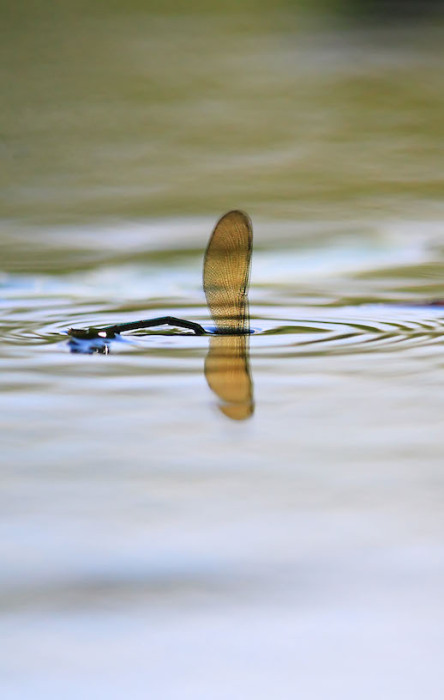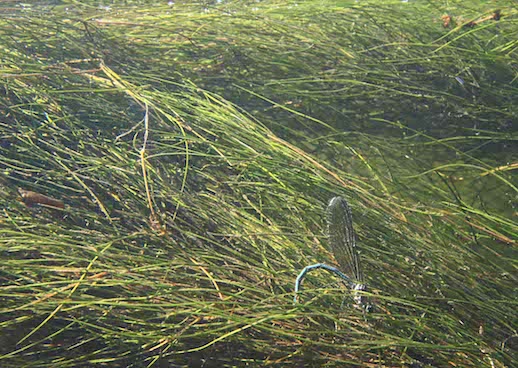
Female dipper, after she had just returned with breakfast for her young
Words and pictures by Mat Bingham
In August 2013 I witnessed something on the river I had never seen before; a female Banded Demoiselle being mobbed by several males whilst she laid eggs on some aquatic vegetation. She had obviously had enough of them squabbling over her so she climbed down a plant stem submerging completely underwater to escape. In all the years of watching dragonflies and damselflies I had never seen this. I looked it up in the dragonfly bible, Dragonflies by Philip Corbet and Stephen Brooks. The book, refers to this behaviour in demoiselles and Common Blue Damselflies but it is rare due to the energy the female must use in submerging (they doesn’t have gills so it is assumed air bubbles trapped on the body are used for breathing). As she submerged I had managed to grab one quick snap before she was gone below the surface. I waited for ages but I didn’t see her again.
My mind was made up that I wanted to photograph this phenomenon from underwater. I looked into buying a waterproof camera housing but the cost was excessive so I decided to build my own, this seemed like a good idea at the time, after all how hard could it be?
A search of the internet for homemade camera housings uncovered one website which gave instructions on how to make one from an elastic band and a plastic bag. I decided this was too risky without good insurance or a healthy bank balance and decided to develop my own design. Over the winter of 2013 I made a prototype from a plastic box and some acrylic I bought online. Once complete my son and I tested it in the bath and found it leaked, badly. So, not to be put off I went back to the drawing board and made some changes to the design, bought some more acrylic and a different box. I made some gaskets from some rubber to get a watertight seal, which I hoped would stop the leaks. The second version of the camera housing was finished in February 2014.
One Sunday afternoon I decided to put my camera in the housing and give it a try for the first time. My son found me some suitable subjects from his extensive plastic dinosaur collection and we spent the afternoon photographing them in the bath. After some fine tuning of the exposure and focusing I began to convince myself this might actually work and what I needed was a real life subject to give it a try on. Luck played a part in this when I took my son for a walk in Lathkill Dale in the spring and we found a pair of dippers nesting on the River Lathkill. The river was ideal, fairly shallow and clear so I could set up the camera to obtain some under and over shots (half above and half below the water). In the evenings after work I made a camera cable release from a stereo cable and had a think about what I could use to reduce the risk of damage to my camera if the housing started to leak. I came up with the idea of putting tampons in the housing to absorb any moisture. After seeking some product advice on the correct type of absorbency from a friend I headed off the following Saturday morning before dawn to give it a try.
The first problem I encountered was that I hadn’t thought about ballast so I had to improvise and weigh the housing down with a rock. I was delighted to see that as the sun came up the dippers ignored the camera and continued using their favourite rock in the river to launch themselves up to the nest. I sat some 15m away to watch and take pictures. Most of the pictures were out of focus and on some water droplets could be seen on the front of the housing. Over the next few weeks I repeated the trial refining my technique and making some further modifications.
I spent most of the summer in 2014 in the river photographing Banded Demoiselle but I didn’t see any females submerge. Banded Demoiselle are a spring to mid summer species and in late July I was due to go on holiday to Scotland. I was fast running out of time. The number of demoiselles on the river was starting to decline. It came down to the last couple of weekends before I would have to shelve the project for another year. On the final Sunday before I was due to go on holiday I had been in the river most of the day, the sky was cloudy and there wasn’t enough light. In the early evening it started to brighten up and look a bit more promising but the demoiselles didn’t seem to want to co-operate with my plan. I had decided to call it a day when a Female Banded Demoiselle landed right in front of me, immediately several males made a play for her. Before I realized what was happing she was submerging barely two feet away. I started to slowly move the housing into position trying not to spook her. She seemed really preoccupied with the business of finding a safe place to lay her eggs in the warm water. I started to take pictures not knowing if they would be exposed properly if they would be in focus or if the composition would be right.
I could see her in the evening light, she looked amazing underwater, no longer the emerald green I was used to but she had taken on a strange silver and blue colour which reminded me of mercury. What I had read seemed correct there were tiny bubbles of air all over her tiny fragile body. She stayed submerged for 30 minutes and then took me by surprise when she shot up to the surface like a cork, emerging onto a plant stem. She flapped her wings once, took to the air and was gone. I stayed in the river for a few minutes to make sense of what I had seen, trying to decide if I had imagined it. Eventually I climbed out and headed for home.
A few hours later I plucked up the courage to look at the photographs. I had got one photograph out of perhaps fifty that I was happy with. I think I shall always remember that day.
As I write this I have plans to take the housing to Scotland to photograph spawning salmon. Not bad for forty quid!

